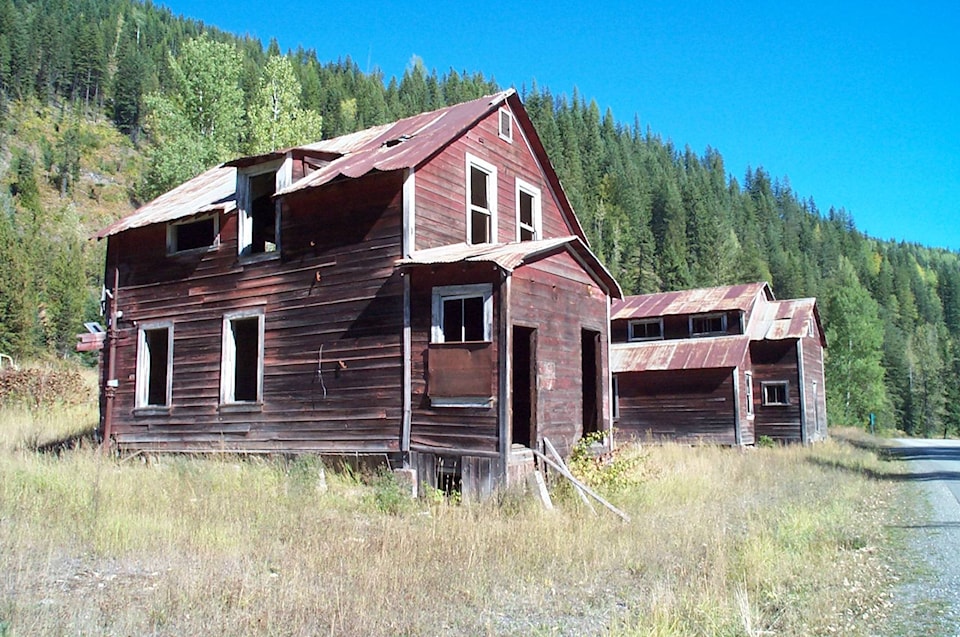Three hundred fifteenth in a series on West Kootenay/Boundary place names
The area along Highway 31A, between Kaslo and New Denver, is known as the Valley of Ghosts (or Valley of the Ghosts), on account of the many vanished towns it was once home to.
The nickname was popularized by Don Blake’s 1988 book Valley of the Ghosts: The History Along Highway 31A. Blake said he didn’t coin the phrase, but couldn’t remember where he saw it.
It first turns up in an anonymous story in the Edmonton Journal on April 28, 1985 and Spokane Spokesman-Review of May 26, 1985 (possibly produced by BC’s tourism ministry): “Turning east on Highway 31A to Kaslo, the road winds through ‘a valley of ghosts.’”
Something similar appeared later that year in a story by Emily-Jane Orford in Northwest Magazine. The name was also used in the Canadian Rockies Bicycling Guide, published the following year.
There’s now a Valley of the Ghosts Music Fest in Sandon.
DEANESHAVEN AND YASODHARA REVISTED
We’ve previously looked at Deaneshaven (or Deanshaven or Dean’s Haven), a nearly obsolete name on the east shore of Kootenay Lake. The community, south of Riondel was named after Richard Teesdale Deane and family, who moved there in 1909.
It was first mentioned in an item in the Nelson Daily News of Sept. 3, 1912: “Born, on Aug. 29, to Mr. and Mrs. George Davis, Dean’s Haven, Kootenay Bay, a son.” Two days later an ad appeared for Crossley gasoline engines: “Full specifications on application to R.T. Deane, Deanshaven.”
We’ve also looked before at Yasodhara. Long before it was an ashram at Kootenay Bay, it was the name of a subdivision marketed toward fruit growers. The earliest mentions were in the Daily News of May 21, 1909, including this one: “Mr. T.H. Langford, who recently purchased a large block of Yasodhara land from the Langford Land company, has since made another purchase … “
We still don’t know who chose the name or why. Yasodhara (pronounced ya-SHOO-dra) is Sanskrit for “bearer of glory” and was the name of the wife of Siddharta Gautama, the founder of Buddhism.
UNUSUAL NAMES, REVISITED
We should have included Yasodhara on our recent lists of unique West Kootenay place names.
Others previously studied in this series that ought to be on the unusual list as well include:
• Casino, named for Casino Creek, and in turn for the Big Casino mine.
• Kraft, a railway siding that took its name from the principal product of the Celgar pulp mill.
• Oatescott, coined by Maj. William Lascelles, after two members of the ill-fated 1912 Scott polar expedition, Capt. L.E.G. (Titus) and Capt. Robert Falcon Scott.
• Remac, which combines the names of the discoverers of the Reeves MacDonald mine.
• Tadanac, which is T for Trail plus Canada backward, and was a Cominco brand name before it was a place.
• Thrums, named for a fictional village in Scotland.
• Vallican, which combines Valley and Slocan.
• Volcanic City, named after Robert (Volcanic) Brown, who owned the Volcanic mining claim.
• Wampsha, at the mouth of Woodbury Creek. Its origin remains a mystery.
• Ymir, named after the Ymir Range, which in turn was named after Ymir, the father of the Norse giants.
EAST TRAIL, REVISITED
In our look at Trail neighbourhoods, we wrote that East Trail was first mentioned in 1915.
But a much earlier example appears in the Trail Creek News of Feb. 12, 1897, in unfortunate circumstances: “The little six year old daughter of Mr. and Mrs. Banbury, residing across the river in East Trail, died Sunday night of diphtheria.”
MILES FERRY, REVISITED
During construction of the City of Nelson’s power plant, John Miles ran a ferry across the Kootenay River.
Previously the earliest known mention of Miles Ferry (or Miles’ Ferry) was from June 1906, but the recently-digitized Daily News reveals the ferry was around as of March 14, 1905: “Miles’ ferry began business yesterday between the site of the proposed city power plant and a point opposite, just a mile above Bonnington falls.”
Miles Ferry was mentioned for the final time in the same newspaper on Dec. 12, 1909 when a new governor for the power plant was said to be on the railway sidetrack there.
SALMOITE
We previously suggested that no word existed to describe people from Salmo and proposed Salmoans. The Nelson Daily News of July 2, 1909, however, preferred Salmoite, as in “A large number of Salmoites took the evening train for the celebration at Nelson.”
In 1926, a mineral was named Salmoite after Salmo.
